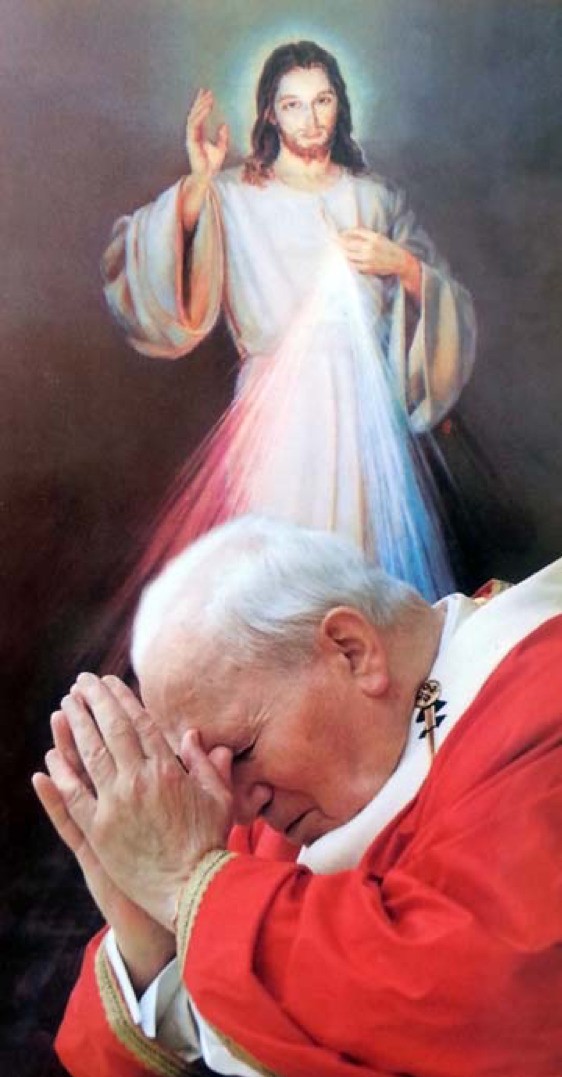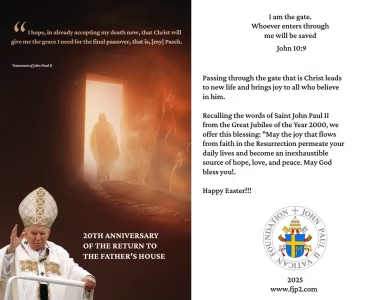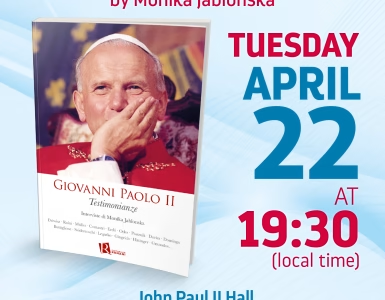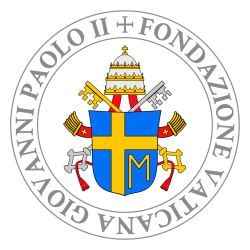Divine Mercy Sunday (also known as the Feast of the Divine Mercy) is celebrated on the Sunday after Easter, the Octave Day of Easter. The feast day is observed by Roman Catholic as well as some Anglicans. It is originally based on the Catholic devotionto the Divine Mercy that Saint Faustine Kowalska reported as part of her encounter with Jesus, and is associated with special promises from Jesus and indulgences issued by the Church.
The feast of Divine Mercy, as recorded in the diary of Saint Faustina, receives from Jesus Himself the biggest promises of grace related to the Devotion of Divine Mercy. In specific, Jesus said that a person who goes to sacramental confession(the confession may take place some days before) and receives holy communion on that day, shall obtain the total forgiveness of all sins and punishment. That means each person would go immediately after death to heaven without suffering in purgatory(or hell). Additionally, the Roman Catholic Church grants a plenary indulgence (observing the usual rules) with the recitation of some simple prayers.
Devotion to the Divine Mercy

Faustina Kowalska, a Polish nun reported visions and visitations from Jesus and conversations with Him. He asked her to paint the vision of His Merciful Divinity being poured from His sacred heart and specifically asked for a feast of Divine Mercy to be established on the first Sunday after Easter so mankind would take refuge in Him:
I want the image solemnly blessed on the first Sunday after Easter, and I want it to be venerated publicly so that every soul may know about it - Jesus’ words, Diary 341
Let all mankind recognize My unfathomable mercy. It is a sign for the end times; after it will come the day of justice – Diary 848
Souls perish in spite of My bitter Passion. I am giving them the last hope of salvation; that is, the Feast of My Mercy. If they will not adore My mercy, they will perish for all eternity… tell souls about this great mercy of Mine, because the awful day, the day of My justice, is near – Diary 965
Sunday, April 28, 1935. Low Sunday; that is, the Feast of The Divine Mercy, the conclusion of the Jubilee of Redemption. When we went to take part in the celebrations, my heart leapt with joy that the two solemnities were so closely united - Faustina’s words, Diary 420
This Feast emerged from the very depths of My mercy, and it is confirmed in the vast depths of my tender mercies. Every soul believing and trusting in My mercy will obtain it - Jesus’ words, Diary 420
Yes, the first Sunday after Easter is the Feast of Mercy, but there must also be deeds of mercy, which are to arise out of love for Me. You are to show mercy to our neighbors always and everywhere. You must not shrink from this or try to absolve yourself from it – Diary 742
In several entries in her diary, Faustina recorded promises of Grace and Mercy associated to the Feast of Divine Mercy on Mercy Sunday. Jesus stated:
Ask of my faithful servant that, on this day, he tell the whole world of My great mercy; that whoever approaches the Fountain of Life on this day will be granted complete forgiveness of sins and punishment. Mankind will not have peace until it turns with trust to My mercy – Diary 300
I desire that the Feast of Mercy be a refuge and shelter for all souls, and especially for poor sinners. On that day, the very depths of My tender mercy are open. I pour out a whole ocean of graces upon those souls who approach the fount of My mercy. The soul that will go to Confession and receive Holy Communion shall obtain the complete forgiveness of sins and punishment. On that day all the divine floodgates through which grace flow are opened. Let no soul fear to draw near to Me, even though its sins be as scarlet – Diary 699
I want to grant a complete pardon to the souls that will go to Confession and receive Holy Communion on the Feast of My Mercy - Diary 1109
On March 23, 1937, Faustina wrote in her diary (Notebook III, item 1044) that she had a vision that the feast of Divine Mercy would be celebrated in her local chapel, and would be attended by large crowds, and that the same celebration would be held in Rome attended by the Pope. She wrote: “The crowd was so enormous that the eye could not take it all in. Everyone was participating in the celebrations.”
Divine Mercy Sunday is also the day after the culmination of the novena of the Chaplet of Divine Mercy. Faustina wrote Jesus instructed her that the Feast of Mercy (the Sunday after Easter) be preceded by a Divine Mercy Novenawhich would begin on Good Friday.
The first Mass during which the Divine Mercy image was displayed was on April 28, 1935, the first Sunday after Easter (the Feast of Divine Mercy) and was attended by Sr. Faustina. (Diary of St. Faustina, item 420). April 28, 1935 was also the celebration of the end of the Jubilee of the Redemptionby Pope Pius XI. Father Michael Sopocko (Faustina’s confessor) celebrated the Mass that Sunday and obtained permission to place the image within the Gate of Dawn church in Vilnius during the Mass.
Vatican approval
The first Divine Mercy painting by Kazimierowski(1934) at the Divine Mercy Sanctuary (Vilnius)
The devotion was actively promoted by Pope John Paul II. On April 30, 2000, the Canonization of Faustyna Kowalska took place and the Sunday after Easter was officially designated as the Sunday of the Divine Mercy (Dominica II Paschae seu de divina misericordia) in the General Roman Calendar. On April 22, 2001, which was one year after establishing Divine Mercy Sunday, Pope John Paul II re-emphasized its message in the resurrection context of Easter:
Jesus said to St. Faustyna one day: “Humanity will never find peace until it turns with trust to Divine Mercy”. Divine Mercy! This is the Easter gift that the Church receives from the risen Christ and offers to humanity.
The devotion to Divine Mercy Sunday grew rapidly after its designation by Pope John Paul II and is now widely celebrated by Catholics. TheDivine Mercy image is often carried in processions on Divine Mercy Sunday, and is placed in a location in the church so that it can be venerated by those who attended the Mass.
The liturgical celebration of Divine Mercy Sunday reflects the devotional elements of Divine Mercy– the first prayer of that Mass beginning with:
Heavenly Father and God of Mercy, we no longer look for Jesus among the dead, for He is alive and has become the Lord of Life.
This opening prayer refers to Divine Mercy as the key element in the plan of God for salvation and emphasizes the belief that it was through mercy that God gave his only son for the redemption of mankind, after the fall of Adam.
John Paul II, who died in April 2005 on the vigil of Divine Mercy Sunday, was himself beatified on Divine Mercy Sunday, May 1, 2011, by his successor, Pope Benedict XVI, and was canonized on Divine Mercy Sunday, April 27, 2014, by Pope Francis.
Plenary Indulgence
In June 2002, John Paul II granted indulgences to Catholics who recite specific prayers on that day, which were then formally decreed by the Apostolic Penitentiary. The priests are also ordered in that day to lead the prayers in honor of Divine Mercy, inform the parishioners about the Divine Mercy, and hear confessions.
Conditions
A display at the Altar on Divine Mercy Sunday at St Pancras Church, Ipswich
This Plenary Indulgence is obtained by observing the usual dispositions that are on place for the granting of this grace through the Intercession of the Catholic Church, that is: Sacramental Confession(the confession may take place some days before), Holy Communion, to pray for the intentions of the pope (an Our Father and Hail Mary is minimum requirement), when the faithful detached from any sin, even venial, either:
- In any church or chapel take part in the prayers and devotions in honor of the Divine Mercy.
- In the presence of the Blessed Sacrament, exposed or reserved in the tabernacle, say an Our Father and Creed.
…in both cases, adding a devout prayer to the Merciful Lord (i.e. “Merciful Jesus, I trust in You.”).
Special dispositions
Additionally, for the faithful who, for a justified reason beyond their control, are unable to go to church or chapel, may obtain forgiveness with the recitation of one Our Father and Creed before a devout image of Jesus adding “Merciful Jesus, I Trust in you.” They will receive the plenary Indulgence that day with the condition of fulfilling the usual sacramental requirements at a later time. Even if the above is impossible to do, the Indulgence is granted if with spiritual intention they unite themselves to the ones carrying on the prescribed practices with the intention of fulfilling the requirements as soon as it is possible.
Wikipedia
HOMILY OF THE HOLY FATHER
Mass in St. Peter Square for the canonization of Sr. Faustina Kowalska – Sunday, 30 April 2000
1.“Confitemini Domino quoniam bonus, quoniam in saeculum misericordia eius”; “Give thanks to the Lord for he is good; his steadfast love endures forever” (Ps118: 1). So, the Church sings on the Octave of Easter, as if receiving from Christ’s lips these words of the Psalm; from the lips of the risen Christ, who bears the great message of divine mercy and entrusts its ministry to the Apostles in the Upper Room: “Peace be with you. As the Father has sent me, even so I send you…. Receive the Holy Spirit. If you forgive the sins of any, they are forgiven; if you retain the sins of any, they are retained” (Jn20: 21-23). Before speaking these words, Jesus shows his hands and his side. He points, that is, to the wounds of the Passion, especially the wound in his heart, the source from which flows the great wave of mercy poured out on humanity. From that heart Sr Faustina Kowalska, the blessed whom from now on we will call a saint, will see two rays of light shining from that heart and illuminating the world: “The two rays”, Jesus himself explained to her one day, “represent blood and water”(Diary).
- Blood and water! We immediately think of the testimony given by the Evangelist John, who, when a solider on Calvary pierced Christ’s side with his spear, sees blood and water flowing from it (cf. Jn19: 34). Moreover, if the blood recalls the sacrifice of the Cross and the gift of the Eucharist, the water, in Johannine symbolism, represents not only Baptism but also the gift of the Holy Spirit (cf. Jn3: 5; 4: 14; 7: 37-39). Divine Mercy reaches human beings through the heart of Christ crucified: “My daughter, say that I am love and mercy personified”, Jesus will ask Sr Faustina (Diary, p. 374). Christ pours out this mercy on humanity though the sending of the Spirit who, in the Trinity, is the Person-Love. And is not mercy love’s “second name” (cf. Dives in misericordia,n. 7), understood in its deepest and most tender aspect, in its ability to take upon itself the burden of any need and, especially, in its immense capacity for forgiveness?
Today my joy is truly great in presenting the life and witness of Sr Faustina Kowalska to the whole Church as a gift of God for our time. By divine Providence, the life of this humble daughter of Poland was completely linked with the history of the 20th century, the century we have just left behind. In fact, it was between the First and Second World Wars that Christ entrusted his message of mercy to her. Those who remember, who were witnesses and participants in the events of those years and the horrible sufferings they caused for millions of people, know well how necessary was the message of mercy. Jesus told Sr Faustina: “Humanity will not find peace until it turns trustfully to divine mercy”(Diary, p. 132). Through the work of the Polish religious, this message has become linked forever to the 20th century, the last of the second millennium and the bridge to the third. It is not a new message but can be considered a gift of special enlightenment that helps us to relive the Gospel of Easter more intensely, to offer it as a ray of light to the men and women of our time.
- What will the years ahead bring us? What will man’s future on earth be like? We are not given to know. However, it is certain that in addition to new progress there will unfortunately be no lack of painful experiences. But the light of divine mercy, which the Lord in a way wished to return to the world through Sr Faustina’s charism, will illumine the way for the men and women of the third millennium. However, as the Apostles once did, today too humanity must welcome into the upper room of history the risen Christ, who shows the wounds of his Crucifixion and repeats: Peace be with you!Humanity must let itself be touched and pervaded by the Spirit given to it by the risen Christ. It is the Spirit who heals the wounds of the heart, pulls down the barriers that separate us from God and divide us from one another, and at the same time, restores the joy of the Father’s love and of fraternal unity.
- It is important then that we accept the whole message that comes to us from the word of God on this Second Sunday of Easter, which from now on throughout the Church will be called “Divine Mercy Sunday”. In the various readings, the liturgy seems to indicate the path of mercy which, while re-establishing the relationship of each person with God, also creates new relations of fraternal solidarity among human beings. Christ has taught us that “man not only receives and experiences the mercy of God, but is also called “to practise mercy’ towards others: “Blessed are the merciful, for they shall obtain mercy’ (Mt5: 7)” (Dives in misericordia, n. 14). He also showed us the many paths of mercy, which not only forgives sins but reaches out to all human needs. Jesus bent over every kind of human poverty, material and spiritual. His message of mercy continues to reach us through his hands held out to suffering man. This is how Sr Faustina saw him and proclaimed him to people on all the continents when, hidden in her convent at £agiewniki in Kraków, she made her life a hymn to mercy: Misericordias Domini in aeternum cantabo.
- Sr Faustina’s canonization has a particular eloquence: by this act I intend today to pass this message on to the new millennium. I pass it on to all people, so that they will learn to know ever better the true face of God and the true face of their brethren. In fact, love of God and love of one’s brothers and sisters are inseparable, as the First Letter of John has reminded us: “By this we know that we love the children of God, when we love God and obey his commandments” (5: 2). Here the Apostle reminds us of the truth of love, showing us its measure and criterion in the observance of the commandments. It is not easy to love with a deep love, which lies in the authentic gift of self. This love can only be learned by penetrating the mystery of God’s love. Looking at him, being one with his fatherly heart, we are able to look with new eyes at our brothers and sisters, with an attitude of unselfishness and solidarity, of generosity and forgiveness. All this is mercy! To the extent that humanity penetrates the mystery of this merciful gaze, it will seem possible to fulfil the ideal we heard in today’s first reading: “The community of believers were of one heart and one mind. None of them ever claimed anything as his own; rather everything was held in common” (Acts 4: 32). Here mercy gave form to human relations and community life; it constituted the basis for the sharing of goods. This led to the spiritual and corporal “works of mercy”. Here mercy became a concrete way of being “neighbor” to one’s neediest brothers and sisters.6. Sr Faustina Kowalska wrote in her Diary: “I feel tremendous pain when I see the sufferings of my neighbors. All my neighbors’ sufferings reverberate in my own heart; I carry their anguish in my heart in such a way that it even physically destroys me. I would like all their sorrows to fall upon me, in order to relieve my neighbor”(Diary, p. 365). This is the degree of compassion to which love leads, when it takes the love of God as its measure! It is this love which must inspire humanity today, if it is to face the crisis of the meaning of life, the challenges of the most diverse needs and, especially, the duty to defend the dignity of every human person. Thus, the message of divine mercy is also implicitly a message about the value of every human being.Each person is precious in God’s eyes; Christ gave his life for each one; to everyone the Father gives his Spirit and offers intimacy.
- This consoling message is addressed above all to those who, afflicted by a particularly harsh trial or crushed by the weight of the sins they committed, have lost all confidence in life and are tempted to give in to despair. To them the gentle face of Christ is offered; those rays from his heart touch them and shine upon them, warm them, show them the way and fill them with hope. How many souls have been consoled by the prayer “Jesus, I trust in you”,which Providence intimated through Sr Faustina! This simple act of abandonment to Jesus dispels the thickest clouds and lets a ray of light penetrate every life. Jezu, ufam tobie.
- Misericordias Domini in aeternum cantabo (Ps88 [89]: 2). Let us too, the pilgrim Church, join our voice to the voice of Mary most holy, “Mother of Mercy”, to the voice of this new saint who sings of mercy with all God’s friends in the heavenly Jerusalem. And you, Faustina, a gift of God to our time, a gift from the land of Poland to the whole Church, obtain for us an awareness of the depth of divine mercy; help us to have a living experience of it and to bear witness to it among our brothers and sisters. May your message of light and hope spread throughout the world, spurring sinners to conversion, calming rivalries and hatred and opening individuals and nations to the practice of brotherhood. Today, fixing our gaze with you on the face of the risen Christ, let us make our own your prayer of trusting abandonment and say with firm hope: Christ Jesus, I trust in you! Jezu, ufam tobie!
Libreria Editrice Vaticana





